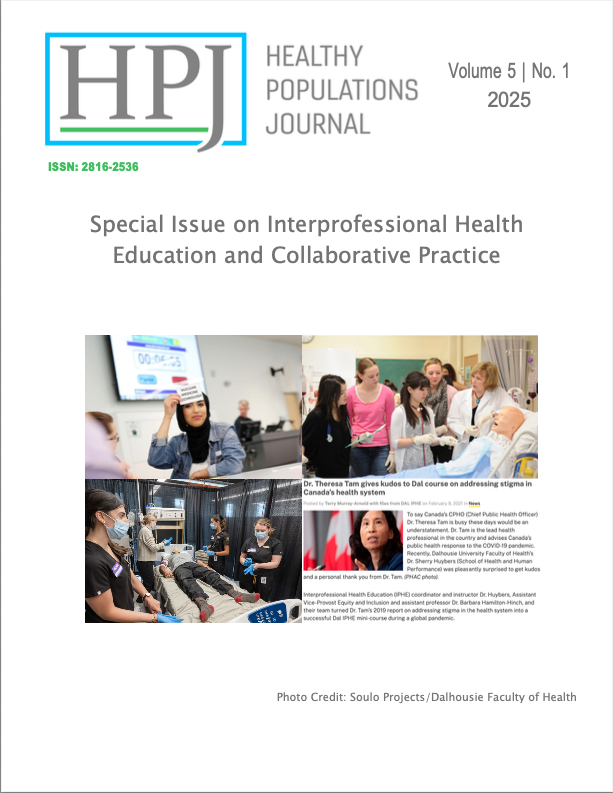You Were Selected for Your Lived Experience: A Love-Centered Evaluation from the Perspective of Teaching Assistants in an IPE Course in Higher Education
DOI:
https://doi.org/10.15273/hpj.v5i1.12352Keywords:
writing as method, post-structural, program evaluation, allyship, post-secondaryAbstract
Introduction. While teaching assistants with diverse backgrounds are subject to biased evaluations and perceptions of capacity due to race and gender, academic perspectives and emotional and psychological impacts of teaching on diverse teaching assistants is lacking. Objective. Applying post-qualitative methods of writing and autoethnography, three PhD level teaching assistants applied a love-centered program evaluation to assess whether they have what they need to facilitate an online asynchronous IPE on allyship. Methods. Over the course of five weeks, the teaching assistants met to discuss a need for this work, designed, and completed the program evaluation. Core evaluation activities included writing a series of self-addressed love letters and meeting for group reflections on the teaching experience and the content of the love letters. What Emerged. Systemic barriers to engaging left the teaching assistants feeling less effective than they had desired. The lack of training and ongoing support systems led to experiences of unanticipated harm. Conclusion. This evaluation aligns with research that suggests that structurally marginalized teaching assistants may require additional support to do their work without harm. Hiring and fairly compensating a small group of teaching assistants to design and deliver a curriculum that aligns with their values and is structured according to realistic learning outcomes may be one way to reduce the harm experienced by teaching assistants facilitating an allyship course.
References
Brown, K. T. (2015). Perceiving allies from the perspective of non-dominant group members: Comparisons to friends and activists. Current Psychology, 34, 713-722.
Canadian Interprofessional Health Collaborative. (2024). CIHC Competency Framework for Advancing Collaboration 2024. www.cihc-cpis.com
Dalhousie Research Ethics. (2024). Guidelines for differentiating among research, program evaluation and quality improvement. Dalhousie University.
Darder, A. (2002). Teaching as an act of love: The classroom and critical praxis. In A. Darder, Reinventing Paulo Freire: A pedagogy of love, 91-149. Westview Press.
Denshire, S. (2014). On auto-ethnography. Current Sociology, 62(6), 831-850.
Ford, J. & Gray, R. (2021). Interprofessional education handbook: For educators and practitioners incorporating integrated care and values-based practice, Centre for Advancement of Interprofessional Education. https://www.caipe.org/resources/publications/caipe-publications/caipe-2021-a-new-caipe-interprofessional-education-handbook-2021-ipe-incorporating-values-based-practice-ford-j-gray-r
Freire, P. (1970). Pedagogy of the oppressed. Penguin Books.
Guffin, J. (2024). Experiencing a Safe Classroom: A Critical Phenomenological Study of Graduate Teaching Assistants in Counselor Education who Teach Diversity and Social Justice Courses.
hooks, b. (1994). Teaching to transgress. Routledge.
hooks, b. (2000). All about love: New visions. William Morrow.
Khalili, H., Gilbert, J., Lising, D., MacMillan, K. M., Xyrichis, A. (2021). Proposed lexicon for the interprofessional field. A reprint publication by InterprofessionalResearch.Global (ISBN: 978-1-7366963-1-6) https://interprofessionalresearch.global/
Lorde, A. (1997). The cancer journals. San Francisco: aunt lute books.
MacKenzie, D., Sponagle, M., & Sibbald, K. (2024a). Introduction. Interprofessional Education: A Resource for Educators. https://caul-cbua.pressbooks.pub/ipe/front-matter/introduction/
MacKenzie, D., Sponagle, M., & Sibbald, K. (2024b). What are your evaluation plans. Interprofessional Education: A Resource for Educators. https://caul-cbua.pressbooks.pub/ipe/part/what-are-your-evaluation-plans/
McDonald, E., Arevalo, G., Ahmed, S., Akhmetov, I., & Demmans Epp, C. (2023, July). Managing TAs at scale: Investigating the experiences of teaching assistants in introductory Computer Science. In Proceedings of the Tenth ACM Conference on Learning@ Scale (pp. 120-131).
Richardson, L., & St. Pierre, E. A. (2000). Writing: A method of inquiry. In The SAGE Handbook of Qualitative Research (3rd ed., pp. 959–978). SAGE Publications.
Rutherford-Hemming, T., & Lioce, L. (2018). State of interprofessional education in nursing: A systematic review. Nurse Educator, 43(1), 9-13.
St. Pierre, E. A. (2021). Post qualitative inquiry, the refusal of method, and the risk of the new. Qualitative Inquiry, 27(1), 3–9. 10.1177/1077800419863005
St. Pierre, E. A. (2023). Poststructuralism and post qualitative inquiry: What can and must be thought. Qualitative Inquiry, 29(1), 20–32. 10.1177/10778004221122282
Tindell, S., Young, L., O’Rear, E., & Morris, P. (2016). Teaching assistant perspectives on a diversity and social justice education course for collegiate agriculture students. NACTA Journal, 60(2), 158-166.
Xu, Y., Lei, Y., & Sezaki, H. (2024). Impact of educational development programs on teaching self-efficacy in graduate students: A systematic literature review. Procedia Computer Science, 246, 4084-4093.
Published
Issue
Section
License
Copyright (c) 2025 Joshua Yusuf, Arezoo Mojbafan, ivan beck

This work is licensed under a Creative Commons Attribution-NonCommercial 4.0 International License.
The journal aims to reduce barriers to publishing and sharing research and inequalities to accessing information.This journal provides immediate open access to its content on the principle that making research freely available to the public supports a greater global exchange of knowledge. The open-access nature of the journal means that there will be no charge for authors or readers to use the journal. The journal has a Creative Commons Attribution Non-Commercial (CCBYNC) attribution which allows the author (and others) to share and distribute their full-text article in other public domains, such as Google Scholar or Research Gate.

